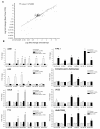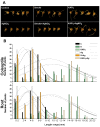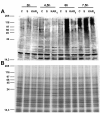Transcriptome analysis of germinating maize kernels exposed to smoke-water and the active compound KAR1
- PMID: 21044315
- PMCID: PMC3095319
- DOI: 10.1186/1471-2229-10-236
Transcriptome analysis of germinating maize kernels exposed to smoke-water and the active compound KAR1
Abstract
Background: Smoke released from burning vegetation functions as an important environmental signal promoting the germination of many plant species following a fire. It not only promotes the germination of species from fire-prone habitats, but several species from non-fire-prone areas also respond, including some crops. The germination stimulatory activity can largely be attributed to the presence of a highly active butenolide compound, 3-methyl-2H-furo[2,3-c]pyran-2-one (referred to as karrikin 1 or KAR1), that has previously been isolated from plant-derived smoke. Several hypotheses have arisen regarding the molecular background of smoke and KAR1 action.
Results: In this paper we demonstrate that although smoke-water and KAR1 treatment of maize kernels result in a similar physiological response, the gene expression and the protein ubiquitination patterns are quite different. Treatment with smoke-water enhanced the ubiquitination of proteins and activated protein-degradation-related genes. This effect was completely absent from KAR1-treated kernels, in which a specific aquaporin gene was distinctly upregulated.
Conclusions: Our findings indicate that the array of bioactive compounds present in smoke-water form an environmental signal that may act together in germination stimulation. It is highly possible that the smoke/KAR1 'signal' is perceived by a receptor that is shared with the signal transduction system implied in perceiving environmental cues (especially stresses and light), or some kind of specialized receptor exists in fire-prone plant species which diverged from a more general one present in a common ancestor, and also found in non fire-prone plants allowing for a somewhat weaker but still significant response. Besides their obvious use in agricultural practices, smoke and KAR1 can be used in studies to gain further insight into the transcriptional changes during germination.
Figures







Similar articles
-
Karrikins discovered in smoke trigger Arabidopsis seed germination by a mechanism requiring gibberellic acid synthesis and light.Plant Physiol. 2009 Feb;149(2):863-73. doi: 10.1104/pp.108.131516. Epub 2008 Dec 12. Plant Physiol. 2009. PMID: 19074625 Free PMC article.
-
A compound from smoke that promotes seed germination.Science. 2004 Aug 13;305(5686):977. doi: 10.1126/science.1099944. Epub 2004 Jul 8. Science. 2004. PMID: 15247439
-
Structure-activity relationships of analogs of 3,4,5-trimethylfuran-2(5H)-one with germination inhibitory activities.J Plant Physiol. 2013 Sep 15;170(14):1235-42. doi: 10.1016/j.jplph.2013.04.002. Epub 2013 May 4. J Plant Physiol. 2013. PMID: 23648109
-
Regulation of seed germination and seedling growth by chemical signals from burning vegetation.Annu Rev Plant Biol. 2012;63:107-30. doi: 10.1146/annurev-arplant-042811-105545. Epub 2012 Feb 9. Annu Rev Plant Biol. 2012. PMID: 22404467 Review.
-
Plant-Derived Smoke and Karrikin 1 in Seed Priming and Seed Biotechnology.Plants (Basel). 2023 Jun 19;12(12):2378. doi: 10.3390/plants12122378. Plants (Basel). 2023. PMID: 37376003 Free PMC article. Review.
Cited by
-
Potential of Smoke-Water and One of Its Active Compounds (karrikinolide, KAR1) on the Phytochemical and Antioxidant Activity of Eucomis autumnalis.Antioxidants (Basel). 2019 Dec 3;8(12):611. doi: 10.3390/antiox8120611. Antioxidants (Basel). 2019. PMID: 31816895 Free PMC article.
-
Cytokinin profiles in ex vitro acclimatized Eucomis autumnalis plants pre-treated with smoke-derived karrikinolide.Plant Cell Rep. 2016 Jan;35(1):227-38. doi: 10.1007/s00299-015-1881-y. Epub 2015 Oct 31. Plant Cell Rep. 2016. PMID: 26521209
-
Long-Term Effects of Cold on Growth, Development and Yield of Narrow-Leaf Lupine May Be Alleviated by Seed Hydropriming or Butenolide.Int J Mol Sci. 2018 Aug 16;19(8):2416. doi: 10.3390/ijms19082416. Int J Mol Sci. 2018. PMID: 30115849 Free PMC article.
-
Plant-Derived Smoke Affects Biochemical Mechanism on Plant Growth and Seed Germination.Int J Mol Sci. 2020 Oct 20;21(20):7760. doi: 10.3390/ijms21207760. Int J Mol Sci. 2020. PMID: 33092218 Free PMC article. Review.
-
Smoke-Isolated Karrikins Stimulated Tanshinones Biosynthesis in Salvia miltiorrhiza through Endogenous Nitric Oxide and Jasmonic Acid.Molecules. 2019 Mar 29;24(7):1229. doi: 10.3390/molecules24071229. Molecules. 2019. PMID: 30934811 Free PMC article.
References
-
- Van Staden J, Jäger AK, Light ME, Burger BV. Isolation of the major germination cue from plant-derived smoke. S Afr J Bot. 2004;10:654–659.
-
- Light ME, Daws MI, Van Staden J. Smoke-derived butenolide: towards understanding its biological effects. S Afr J Bot. 2009;10:1–7. doi: 10.1016/j.sajb.2008.10.004. - DOI
Publication types
MeSH terms
Substances
Associated data
- Actions
LinkOut - more resources
Full Text Sources
Molecular Biology Databases

